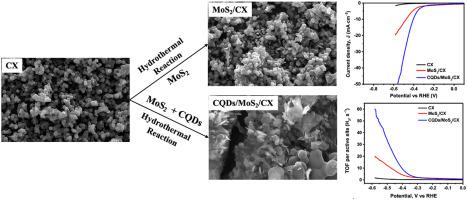Tailoring MoS2 nanosheets dispersion on carbon xerogel with carbon quantum dots for efficient hydrogen evolution reaction
IF 8.3
2区 工程技术
Q1 CHEMISTRY, PHYSICAL
引用次数: 0
Abstract
Achieving uniform dispersion of 2D molybdenum disulfide (MoS2) nanosheets remains a significant challenge due to their strong van der Waals interactions and tendency to aggregate, which limits catalytic efficiency for the hydrogen evolution reaction (HER). In this work, a multidimensional electrocatalyst was developed by combining 3D carbon xerogel (CX), 2D MoS2 nanosheets, and 0D carbon quantum dots (CQDs). CX was first functionalized with MoS2 via hydrothermal treatment to form a MoS2/CX composite. Subsequently, CQDs, derived from g-C3N4, were introduced during the MoS2 growth process to fabricate a CQDs/MoS2/CX hybrid. The addition of CQDs significantly improved the dispersion of MoS2 on the CX surface. The resulting 0D/2D/3D hybrid structure was employed as electrocatalyst for HER in 1 M KOH. The CQDs/MoS2/CX composite achieved a low overpotential of 180 mV at 10 mA cm−2, a Tafel slope of 103 mV dec−1, and retained 96 % of its activity after prolonged operation.

利用碳量子点调整MoS2纳米片在碳干凝胶上的分散,实现高效析氢反应
实现二维二硫化钼(MoS2)纳米片的均匀分散仍然是一个重大挑战,因为它们具有强烈的范德华相互作用和聚集倾向,这限制了析氢反应(HER)的催化效率。在这项工作中,将三维碳干凝胶(CX)、二维MoS2纳米片和零维碳量子点(CQDs)结合在一起,开发了一种多维电催化剂。CX首先通过水热处理与MoS2功能化,形成MoS2/CX复合材料。随后,在MoS2生长过程中引入由g-C3N4衍生的CQDs,以制备CQDs/MoS2/CX杂化材料。CQDs的加入显著改善了MoS2在CX表面的分散。得到的0D/2D/3D杂化结构在1 M KOH条件下用作HER的电催化剂。CQDs/MoS2/CX复合材料在10 mA cm−2下的过电位为180 mV, Tafel斜率为103 mV dec−1,并且在长时间运行后保持了96%的活性。
本文章由计算机程序翻译,如有差异,请以英文原文为准。
求助全文
约1分钟内获得全文
求助全文
来源期刊

International Journal of Hydrogen Energy
工程技术-环境科学
CiteScore
13.50
自引率
25.00%
发文量
3502
审稿时长
60 days
期刊介绍:
The objective of the International Journal of Hydrogen Energy is to facilitate the exchange of new ideas, technological advancements, and research findings in the field of Hydrogen Energy among scientists and engineers worldwide. This journal showcases original research, both analytical and experimental, covering various aspects of Hydrogen Energy. These include production, storage, transmission, utilization, enabling technologies, environmental impact, economic considerations, and global perspectives on hydrogen and its carriers such as NH3, CH4, alcohols, etc.
The utilization aspect encompasses various methods such as thermochemical (combustion), photochemical, electrochemical (fuel cells), and nuclear conversion of hydrogen, hydrogen isotopes, and hydrogen carriers into thermal, mechanical, and electrical energies. The applications of these energies can be found in transportation (including aerospace), industrial, commercial, and residential sectors.
 求助内容:
求助内容: 应助结果提醒方式:
应助结果提醒方式:


